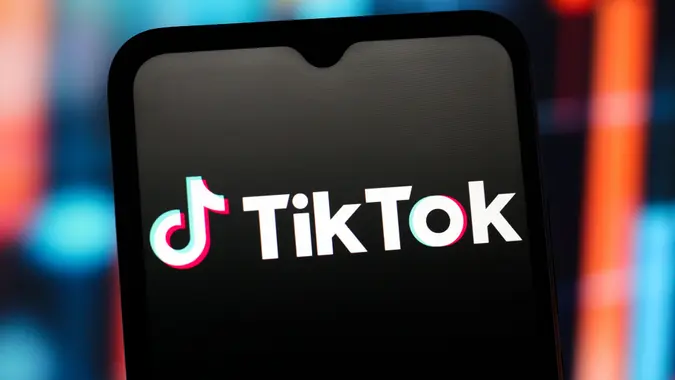SBA Loans: Types, How They Work and How To Qualify

Commitment to Our Readers
GOBankingRates' editorial team is committed to bringing you unbiased reviews and information. We use data-driven methodologies to evaluate financial products and services - our reviews and ratings are not influenced by advertisers. You can read more about our editorial guidelines and our products and services review methodology.

20 Years
Helping You Live Richer

Reviewed
by Experts

Trusted by
Millions of Readers
Securing funds to get a small business started or keep a floundering small business afloat can be a challenge if you turn to traditional lenders — especially if you don’t have a stellar credit report. Thankfully, the Small Business Association — an extension of the U.S. government — exists to help small business owners get funds they need through its partnerships with public and private organizations.
Read on to find out what you need to know about getting an SBA loan to get your small business started.
What Is an SBA Loan?
An SBA loan is a small business loan that you apply for through an authorized SBA lender to help pay for things such as new equipment or supplies, a commercial mortgage or existing debt. Although the lender is the one loaning you the money, the loan is backed by the SBA, which means that the SBA is guaranteeing the loan and reducing the risk for lenders. In addition, the SBA sets the loan terms and the interest rate, which will be lower than a rate you could get with a private loan.
Types of SBA Loans
Before applying for an SBA loan, it’s important to know the options available and which may best suit your needs.
| Loan Type | Amount | Best For | Key Features |
| SBA 7(a) Loan | Up to $5M | General business financing | Flexible use, long terms for repayment |
| SBA 504 Loan | Up to $5.5M | Real estate, equipment | Fixed-rate financing for assets |
| SBA Microloan | Up to $50K | Startups, small businesses | Shorter terms for repayment |
| SBA Disaster Loan | Up to $2M | Disaster recovery | Low-interest financing for emergencies |
| SBA Express Loan | Up to $500K | Quick funding needs | Streamlined process for applying |
How To Qualify For an SBA Loan
Because the government backs SBA loans, lenders don’t have to assume the risk of a small business owner defaulting. Therefore, it’s much easier to qualify for an SBA loan than for small-business financing through a traditional lender. To qualify, you will need to meet SBA loan requirements:
- You must own a for-profit business that is located and operates in the U.S. or its territories.
- Your business will need to meet SBA size standards.
- You must have invested your own time and money into the business.
- You must have exhausted other options for securing lending.
How To Apply for an SBA Loan
When you’ve had trouble qualifying for a traditional small business loan or you fear you might not qualify for a traditional small business loan, a loan backed by the SBA is a good option. Here are the steps for applying for SBA loan:
1. Create a Business Plan
When you apply for funding for your small business, most lenders will expect you to have prepared a small business plan. For help, you can use the SBA’s free, online business plan tool. After creating an account, you can get started.
2. Know How Much You Need To Borrow and How You Will Use It
Before you apply for an SBA small business loan, you need to know the amount of money you’ll need and how you’ll use the funds. Lenders need to know that the money will be used to directly benefit your business before your loan can be approved.
3. Check Your Credit Report
Lenders use credit reports to determine interest rates, so it’s always a good idea to check your personal — and business, if applicable — credit report for errors before you apply for a loan. You don’t want to be surprised by unexpected information in your credit report that could prevent or delay funding once your loan application is in process.
4. Complete Financial Projections
You’ll need to complete projected income and cash flow statements for at least a year or until the statements show positive cash flow, according to the SBA. You’ll also need to be prepared to discuss your game plan if your financial projections don’t pan out.
5. Gather Other Paperwork
To be as prepared as possible, gather paperwork that might be requested by the lender. Here are some items to consider, according to the SBA:
- Building lease or proposed lease
- Franchise and purchase agreements
- Articles of Incorporation, if applicable
- Partnership agreements
- Copies of business licenses and registrations
- Copies of third-party contracts
6. Assess Your Property for Potential Collateral
Even though an SBA small-business loan is backed by the government, that doesn’t mean the lender doesn’t have any risk involved. The lender might ask you to provide collateral to further guarantee your loan. Some examples of collateral are inventory, property or a vehicle.
7. Know Your Industry
If you’re inexperienced in the industry in which you are planning to start a business, you’ll want to do plenty of research to reassure the lender that you have some helpful knowledge. Otherwise, the lender might be reluctant to loan you the funds.
8. Find a Lender for SBA Loans
The easiest way to find a lender for an SBA loan is to use Lender Match, which can connect you with SBA-approved lenders. All you have to do is answer a few questions and wait a couple days for interested, SBA-approved lenders to contact you with loan offers.
Note that using Lender Match doesn’t guarantee that you will find a lender that will approve you for a loan; it’s simply a tool to help you locate SBA-approved lenders in your area.
9. Compare Rates and Terms
Once lenders reply to you with their offers, it’s time to compare the different rates and terms that are available to you. Ask lenders any questions you might have and then apply according to the lender’s instructions.
10. Prepare and Submit Your Application
After settling on a lender, it’s time to put that paperwork you gathered to use. Along with relevant financial statements and supporting documentation from your business, you’ll need to fill out SBA forms such as:
- SBA Form 1919 (Borrow Information)
- SBA Form 413 (Personal Financial Statement)
- SBA Form 912 (Statement of Personal History)
- SBA Form 148 (Unconditional Guarantee — anyone with 20% or more in ownership must provide this; if you have less than 20% ownership you can provide SBA Form 148L)
Once all of this is complete, submit the entire application package to your SBA lender.
How Long Will It Take To Be Approved?
The SBA works with regular, certified and preferred lenders, and approval times vary. Once you prepare your loan package — consult with the SBA if you need help — you’ll submit to lenders. When a lender approves your loan, they will submit your loan package to the SBA.
You can expect applications submitted to the SBA to be approved within 30 to 90 days, depending on the type of loan and lender, according to SMB Compass.
What To Do If You’re Not Approved
If you’re not approved for a small business loan, find out why and then work toward correcting the issues. For example, if your credit needs improving, consider working with a reputable credit counseling agency. If your loan package wasn’t completed correctly, consult with the SBA for help. The key is to avoid becoming discouraged. With time and effort, you have a good chance of being approved.
FAQ
- How long does it take to get approved for an SBA loan?
- Approval times vary widely based on loan type and lender. In general, it takes anywhere from 30 to 90 days.
- What is the minimum credit score required for an SBA loan?
- The SBA doesn't have a minimum credit score to apply, but most lenders won't consider a small business owner with a credit score that's not in the mid- to high 600s.
- Can startups qualify for SBA loans?
- Yes, startups can qualify for SBA loans, but likely won't be approved for larger loan types. A startup will have an easier time securing an SBA microloan since those are made for fledgling businesses in the early stages.
- Are SBA loans only for small businesses?
- SBA loans are primarily for small businesses, but they can also be used by other businesses and individuals for disaster relief.
- Do I need collateral to get an SBA loan?
- Yes.
- What happens if I default on an SBA loan?
- After a certain period of missed payments, such as a few months, the lender will consider the loan delinquent. At this point they can seize your collateral, file a claim with the SBA for reimbursement and potentially transfer the loan to the U.S. Treasury Department. The Treasury has the power to garnish your wages, withhold your tax refund money and even file a lawsuit. If you're worried you may default on your SBA loan, it's better to explore solutions beforehand such as refinancing for lower monthly payments, negotiating with your lender or considering filing for bankruptcy.
 Written by
Written by  Edited by
Edited by 






















